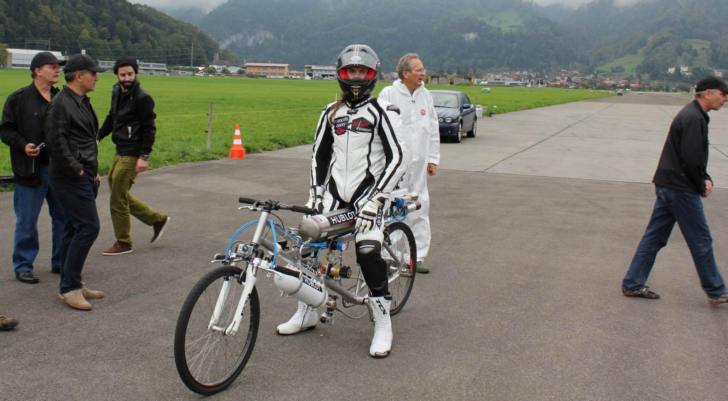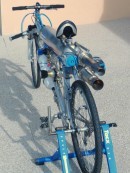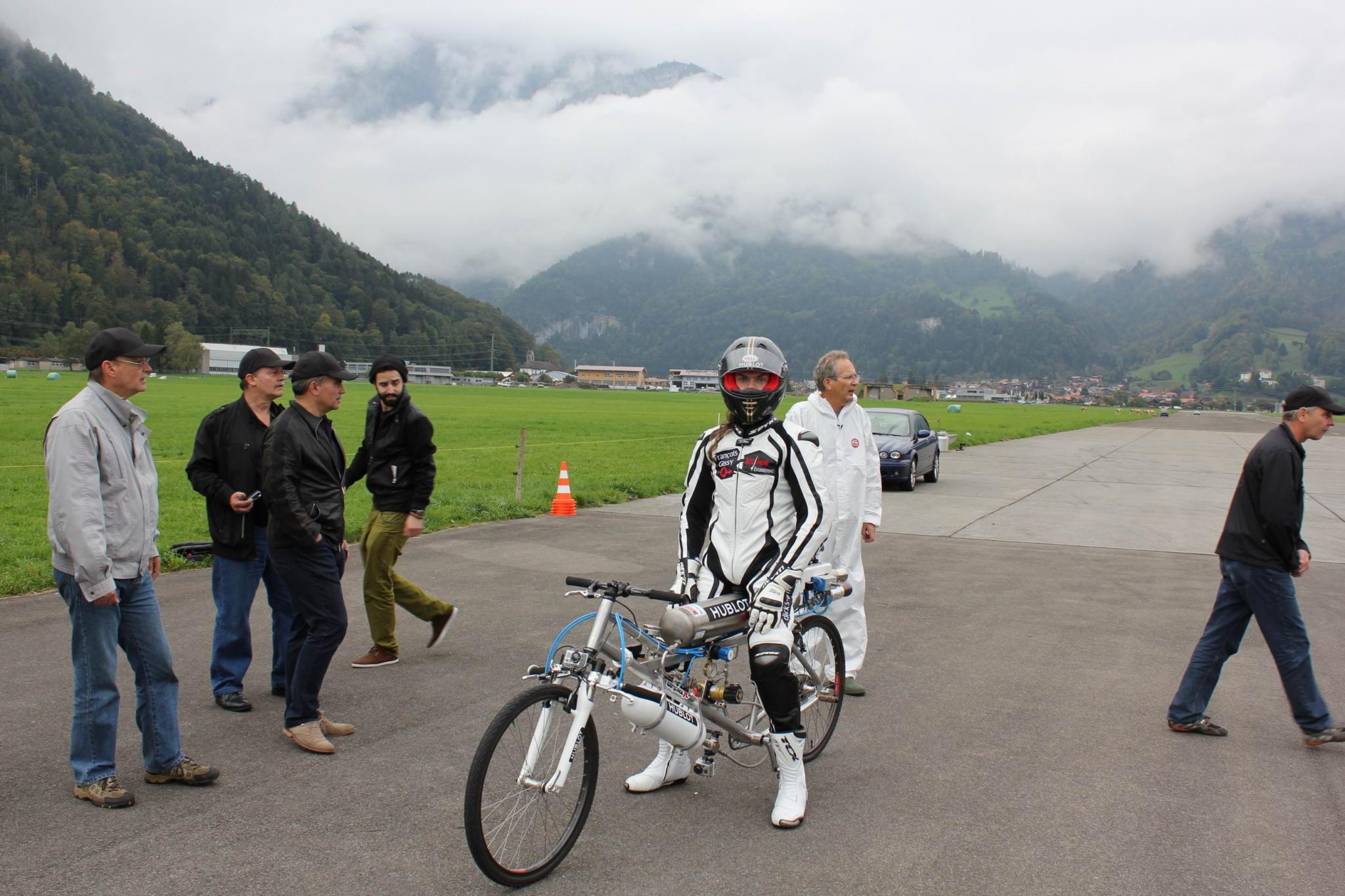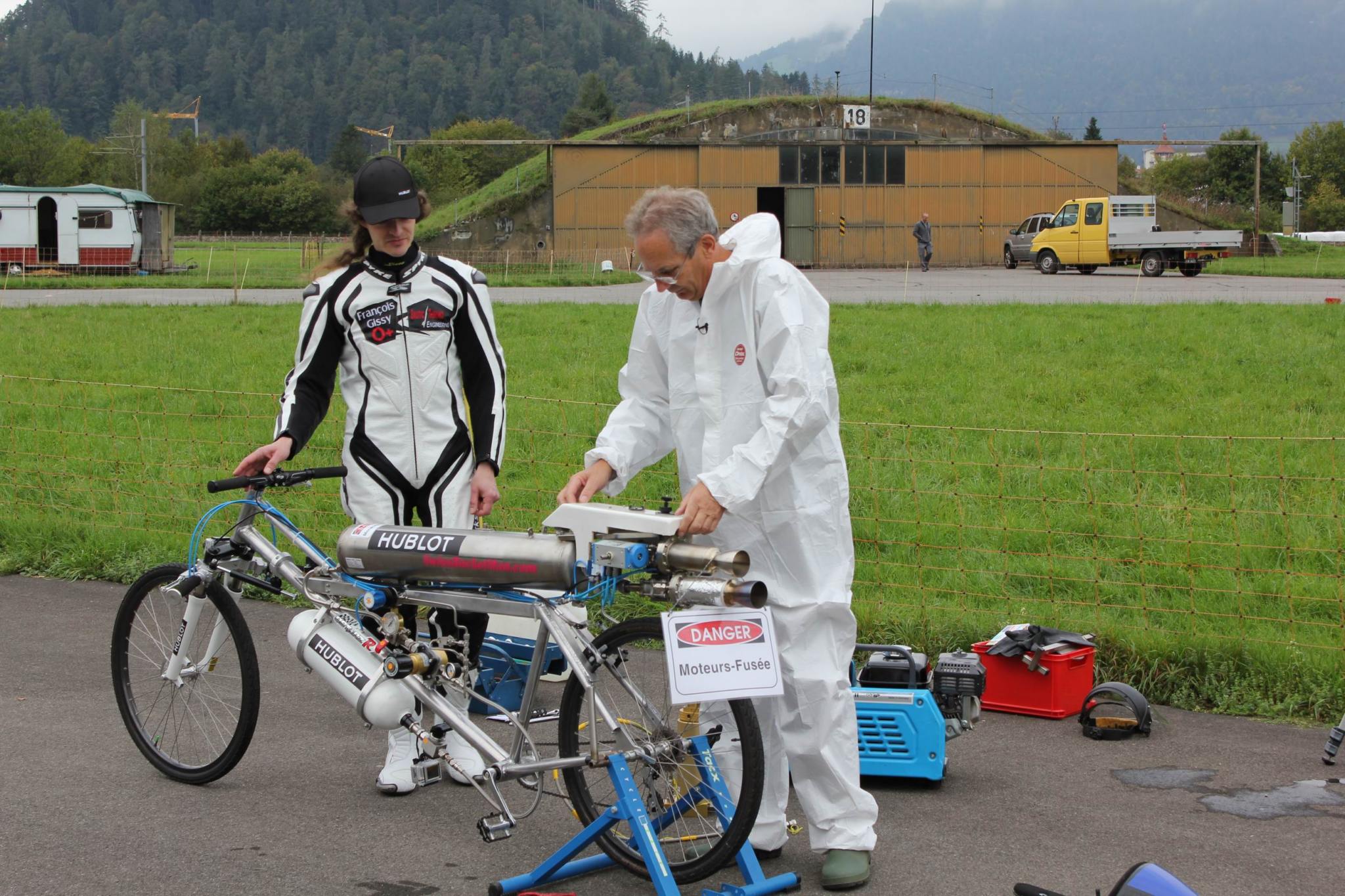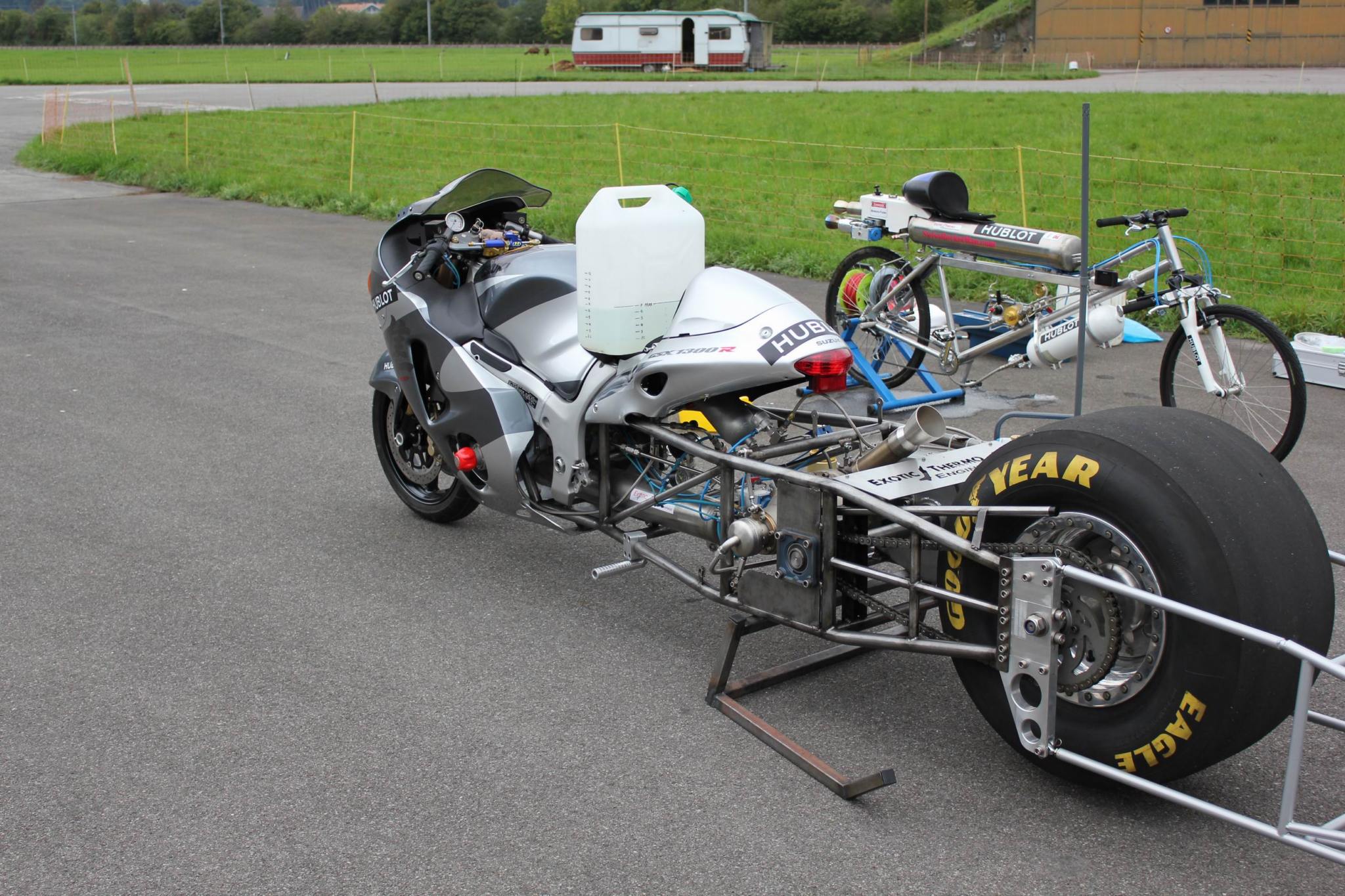He's 31 and he is a bus driver. He's also the fastest bicyclist in the world. Daring Swiss Francois Gissy is the man who reached 285 km/h (177.12 mph) riding his rocket engine-propelled mountain bike on a flat track in Switzerland, just weeks ago.
Such a crazy feat could not go without an interview on autoevolution,so strap on to your seats, we're riding fast!
autoevolution: What does the world look like at 285 km/h ON A BICYCLE?
Francois Gissy: It is difficult to describe the sensation. On one side it is so fast and intense: the acceleration is quick, the bicycle wobbles, and vibrations are huge on the bad surface of the track (the bicycle is rigid). The wind blast is so strong when you are getting close to the peak speed.
On the other side, when you are riding at more than 250 km/h and suddenly your head is pulled backward with a high force (that was not a good idea to add a GoPro on the helmet), the last second of acceleration seemed an eternity.
You are going so fast on this skinny bicycle with rubber brakes, and you see the end of the track which is approaching dangerously quickly, it is pretty impressive.
Moreover, the riding position on the bicycle and the lack of fairing to hide the ground below, gives the scary sensation that you are flying on a broomstick! Compared to this bicycle, even the worst motorcycle seems a Honda Gold Wing!
ae: You love speed, how come you're not into motorcycle racing? Or are you?
FG: Since I was young I always rode on motorcycles, scooters, mopeds. In fact, I am fascinated by motorbikes, whether they are sportbikes, supermoto, MX bikes. That was my number one passion for long time.
Of course, spicy bikes are my preferences. The only reason why I was not involved in racing was the finances. The rocket bicycle became a priority and I had to make choices, because money is limited.
ae: Who came up with this crazy idea and when?
FG: The rocket bicycle is not my idea. In fact, it is even a pretty old idea! During the 1920s and 1930s in Germany, there already were experiments with such rocket-propelled bicycles!
Things got serious in 1995 when my colleague Arnold Neracher was asked by the new “Kamikaze” brand to design a rocket propulsion device in order to give speed to a mountain bike on flat grounds, instead of the usual speed skiing slopes or volcanoes used for speed records.
A video from 1995 about this story can be watched here:
In the team we are guys who like challenges: things that are or seem too easy are not as interesting. Anyone can buy a Busa and ride 300 km/h on a highway. My grandma could do that.
Strap a rocket thruster to a bicycle frame seems easy, but when you sit on it, fuel tank under pressure, you realize that you are maybe a little crazy to be there. Especially when you remember that when you tested this new model of rocket bicycle for the first time, it ended with a crash.
Speed and adrenaline are not the only reasons of this machine. In our team we are fascinated by science and engineering, and this rocket bicycle is an interesting way to mix science with fun.
ae: Was it hard to make people support you in this project?
FG: If they don’t like you, it is not a problem “Hey, go for it, full thrust”; but if they care about you, of course it is more difficult to convince them. Nevertheless, you can have a bad accident with your bike on the road, even at low speed, because of many reasons.
I prefer having an accident when riding this fantastic machine than be killed in a road crash and having engraved on my tombstone “Killed by a drunk driver”.
ae: How about Guinness Book of Records homologation?
FG: In order to have the presence of a Guinness Book official is really expensive. I prefer spending money on the bike’s upgrades. A GPS with an update rate of 10Hz is very precise and you cannot fool such device.
For my team it is more grateful to know that we achieved a peak speed of 285 km/h even if it won’t be on the Guinness book, compared to achieve 270 km/h and being in the Guinness Book. Money must be spent in useful things: performance first!
ae: Can you share with our readers the modifications you have done to the bike? The last run was way faster!
FG: The bicycle was 100% the same on October 7 than on May 19 when I reached 263 km/h.We just have poured a little more H2O2 in the tank and we have set a higher pressure into the thrust chamber. The hydrogen peroxide was also more concentrated, 86% instead of 82%.
ae: Will you be even faster? What are your next plans?
FG: I hope I will be faster. Nevertheless, this 285 km/h run was not a stroll, it was intense. Going faster is possible but we have to make modifications on many parameters.
And first of all, we have to find another track, which has to be smoother! For the next year we will upgrade the rocket bicycle by working in conjunction with the Hublot R&D department. For now we prefer not to tell you much, so the surprise will be better!
Lot of people told us: “Just add a fairing”. Of course it would be easier and safer to go faster with aero accessories, but the bicycle has to be 100% stripped, otherwise it won’t be a regular bicycle. That’s the same for the wheels and the brakes.
This is a true challenge to get that fast on a lightweight bicycle and staying on ground while exposed to such strong a wind. At 285 km/h, the force of the wind was approximately 50% higher than the total weight of the bike plus rider !!!
Another detail I would like to lighten is about the comments of some people who say it’s not a bicycle because there is a thruster on it. Of course it’s not the rotation of the pedals which will move the bike to such speeds, except maybe if you are Iron Man or Chuck Norris, or in the slipstream of a pace vehicle.
That’s exactly the same for a guy who rides downhill a speed skiing slope. In this case he uses a gravity engine. Depending of the total weight and the angle of the slope, that’s a certain amount of force. Somehow it’s like an invisible thruster.
But even if you are not pedaling on your bicycle when you are riding downhill, you are still on a bicycle and not on a motorcycle. If now you decide to strap a rocket on the frame of your bicycle, you can now gain speed on flat grounds, but you are still on the same skinny bicycle and not on a Hayabusa.
Compare a heavy motorcycle with a full-fairing to a naked and lightweight skinny bicycle is like comparing a Concorde to a Blériot XI. The Concorde is a masterpiece of engineering, but flying at Mach 2 is not supposed to be scary for the passengers.
If you strap a Concorde’s afterburning turbojet engine on the Blériot XI wooden frame, and accelerate up to “only” Mach 1, it will probably be one hell of a ride!
ae: Seriously now, why not motorcycles?
FG: There are numerous reasons for the bicycle. First, it was a question of finances, because for a same level of performance, everything will be smaller and cheaper compared to a heavier rocket motorcycle.
The second reason is because it is more challenging than a rocket motorcycle. By the way, we also have a rocket motorcycle in our drawers, still unfinished and waiting.
The third reason is because the bicycle is more widely used throughout the world. Almost every one possesses a bicycle and can imagine what it would be to strap a rocket on it.
With a motorcycle, you are almost limited to the motorcyclist community. The motorcycle world is my world, nevertheless for a better coverage, the bicycle is better.
That’s the reason why at this time we focus on this project. Nevertheless, if one day a rocket motorcycle will really be asked, we will bring heavy artillery! We are not the kind of guys doing things halfway… Do it well or don’t do it. We also have interesting projects in many other fields. We’ll see in the future…
ae: Feel free to add anything you like, and thanks for the time you took to talk to us.
FG: To end this interview, we would like to thank our sponsor HUBLOT and all people who made it possible to have reached this point. To be followed…
And thanks for your time, Florin!
autoevolution: What does the world look like at 285 km/h ON A BICYCLE?
Francois Gissy: It is difficult to describe the sensation. On one side it is so fast and intense: the acceleration is quick, the bicycle wobbles, and vibrations are huge on the bad surface of the track (the bicycle is rigid). The wind blast is so strong when you are getting close to the peak speed.
On the other side, when you are riding at more than 250 km/h and suddenly your head is pulled backward with a high force (that was not a good idea to add a GoPro on the helmet), the last second of acceleration seemed an eternity.
You are going so fast on this skinny bicycle with rubber brakes, and you see the end of the track which is approaching dangerously quickly, it is pretty impressive.
Moreover, the riding position on the bicycle and the lack of fairing to hide the ground below, gives the scary sensation that you are flying on a broomstick! Compared to this bicycle, even the worst motorcycle seems a Honda Gold Wing!
ae: You love speed, how come you're not into motorcycle racing? Or are you?
FG: Since I was young I always rode on motorcycles, scooters, mopeds. In fact, I am fascinated by motorbikes, whether they are sportbikes, supermoto, MX bikes. That was my number one passion for long time.
Of course, spicy bikes are my preferences. The only reason why I was not involved in racing was the finances. The rocket bicycle became a priority and I had to make choices, because money is limited.
ae: Who came up with this crazy idea and when?
FG: The rocket bicycle is not my idea. In fact, it is even a pretty old idea! During the 1920s and 1930s in Germany, there already were experiments with such rocket-propelled bicycles!
Things got serious in 1995 when my colleague Arnold Neracher was asked by the new “Kamikaze” brand to design a rocket propulsion device in order to give speed to a mountain bike on flat grounds, instead of the usual speed skiing slopes or volcanoes used for speed records.
A video from 1995 about this story can be watched here:
In the team we are guys who like challenges: things that are or seem too easy are not as interesting. Anyone can buy a Busa and ride 300 km/h on a highway. My grandma could do that.
Strap a rocket thruster to a bicycle frame seems easy, but when you sit on it, fuel tank under pressure, you realize that you are maybe a little crazy to be there. Especially when you remember that when you tested this new model of rocket bicycle for the first time, it ended with a crash.
Speed and adrenaline are not the only reasons of this machine. In our team we are fascinated by science and engineering, and this rocket bicycle is an interesting way to mix science with fun.
ae: Was it hard to make people support you in this project?
FG: If they don’t like you, it is not a problem “Hey, go for it, full thrust”; but if they care about you, of course it is more difficult to convince them. Nevertheless, you can have a bad accident with your bike on the road, even at low speed, because of many reasons.
I prefer having an accident when riding this fantastic machine than be killed in a road crash and having engraved on my tombstone “Killed by a drunk driver”.
ae: How about Guinness Book of Records homologation?
FG: In order to have the presence of a Guinness Book official is really expensive. I prefer spending money on the bike’s upgrades. A GPS with an update rate of 10Hz is very precise and you cannot fool such device.
For my team it is more grateful to know that we achieved a peak speed of 285 km/h even if it won’t be on the Guinness book, compared to achieve 270 km/h and being in the Guinness Book. Money must be spent in useful things: performance first!
ae: Can you share with our readers the modifications you have done to the bike? The last run was way faster!
FG: The bicycle was 100% the same on October 7 than on May 19 when I reached 263 km/h.We just have poured a little more H2O2 in the tank and we have set a higher pressure into the thrust chamber. The hydrogen peroxide was also more concentrated, 86% instead of 82%.
ae: Will you be even faster? What are your next plans?
FG: I hope I will be faster. Nevertheless, this 285 km/h run was not a stroll, it was intense. Going faster is possible but we have to make modifications on many parameters.
And first of all, we have to find another track, which has to be smoother! For the next year we will upgrade the rocket bicycle by working in conjunction with the Hublot R&D department. For now we prefer not to tell you much, so the surprise will be better!
Lot of people told us: “Just add a fairing”. Of course it would be easier and safer to go faster with aero accessories, but the bicycle has to be 100% stripped, otherwise it won’t be a regular bicycle. That’s the same for the wheels and the brakes.
This is a true challenge to get that fast on a lightweight bicycle and staying on ground while exposed to such strong a wind. At 285 km/h, the force of the wind was approximately 50% higher than the total weight of the bike plus rider !!!
Another detail I would like to lighten is about the comments of some people who say it’s not a bicycle because there is a thruster on it. Of course it’s not the rotation of the pedals which will move the bike to such speeds, except maybe if you are Iron Man or Chuck Norris, or in the slipstream of a pace vehicle.
That’s exactly the same for a guy who rides downhill a speed skiing slope. In this case he uses a gravity engine. Depending of the total weight and the angle of the slope, that’s a certain amount of force. Somehow it’s like an invisible thruster.
But even if you are not pedaling on your bicycle when you are riding downhill, you are still on a bicycle and not on a motorcycle. If now you decide to strap a rocket on the frame of your bicycle, you can now gain speed on flat grounds, but you are still on the same skinny bicycle and not on a Hayabusa.
Compare a heavy motorcycle with a full-fairing to a naked and lightweight skinny bicycle is like comparing a Concorde to a Blériot XI. The Concorde is a masterpiece of engineering, but flying at Mach 2 is not supposed to be scary for the passengers.
If you strap a Concorde’s afterburning turbojet engine on the Blériot XI wooden frame, and accelerate up to “only” Mach 1, it will probably be one hell of a ride!
ae: Seriously now, why not motorcycles?
FG: There are numerous reasons for the bicycle. First, it was a question of finances, because for a same level of performance, everything will be smaller and cheaper compared to a heavier rocket motorcycle.
The second reason is because it is more challenging than a rocket motorcycle. By the way, we also have a rocket motorcycle in our drawers, still unfinished and waiting.
The third reason is because the bicycle is more widely used throughout the world. Almost every one possesses a bicycle and can imagine what it would be to strap a rocket on it.
With a motorcycle, you are almost limited to the motorcyclist community. The motorcycle world is my world, nevertheless for a better coverage, the bicycle is better.
That’s the reason why at this time we focus on this project. Nevertheless, if one day a rocket motorcycle will really be asked, we will bring heavy artillery! We are not the kind of guys doing things halfway… Do it well or don’t do it. We also have interesting projects in many other fields. We’ll see in the future…
ae: Feel free to add anything you like, and thanks for the time you took to talk to us.
FG: To end this interview, we would like to thank our sponsor HUBLOT and all people who made it possible to have reached this point. To be followed…
And thanks for your time, Florin!
